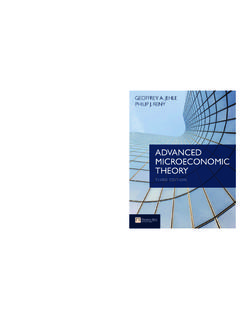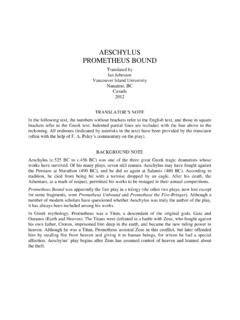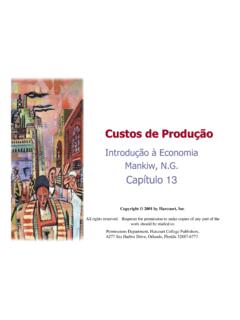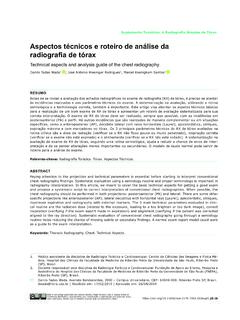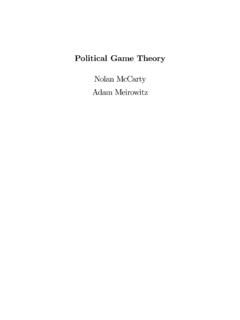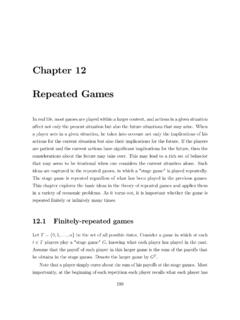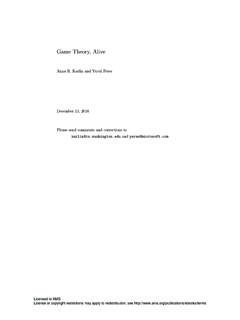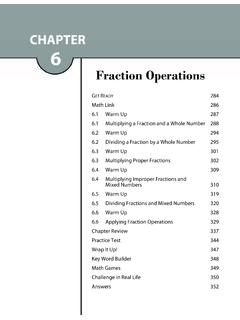Transcription of Microeconomic Theory: Basic Principles and Extensions
1 MICROECONOMICTHEORYBASIC Principles AND EXTENSIONSTENTH EDITIONThis page intentionally left blank MICROECONOMICTHEORYBASIC Principles AND EXTENSIONSTENTH EDITIONW alter NicholsonAmherst CollegeChristopher SnyderDartmouth CollegeVP/Editorial Director:Jack W. CalhounEditor-in-Chief:Alex von RosenbergExecutive Editor:Mike RocheSr. Developmental Editor:Susan SmartSr. Content Project Manager:Cliff KallemeynProduction TechnologyAnalyst:Adam GrafaExecutive MarketingManager:Brian JoynerSr. Marketing Manager:John CareyArt Director:Michelle KunklerSr. First Print Buyer:Sandee MilewskiPrinter:West GroupEagan, MNMicroeconomic TheoryBasic Principles and ExtensionsTenth EditionWalter Nicholson Christopher SnyderCOPYRIGHT 2008, 2005 Thomson South-Western, a partof The Thomson , the Star logo, andSouth-Western are trademarksused herein under in the United States ofAmerica1234510090807 ISBN 13: 978-0-324-42162-0 ISBN 10: 0-324-42162-1 ALL RIGHTS part of this work covered bythe copyright hereon may bereproduced or used in any formor by any means graphic, elec-tronic, or mechanical, includingphotocopying, recording, taping,Web distribution or informationstorage and retrieval systems, orin any other manner withoutthe written permission of permission to use materialfrom this text or product, submit arequest online at of Congress ControlNumber.
2 2007921464 Thomson Higher Education5191 Natorp BoulevardMason, OH 45040 USAFor more information aboutour products, contact us at:Thomson Learning AcademicResource Center1-800-423-0563To Beth, Sarah, David, Sophia, and AbbyTo MauraThis page intentionally left blank About the AuthorsWalter Nicholson is the Ward H. Patton Professor of Economics at Amherst College. Hereceived his in mathematics from Williams College and his in economics fromMIT. Professor Nicholson s principal research interests are in the econometric analyses oflabor market problems including unemployment, job training, and the impact of inter-national trade. He is also the co-author (with Chris Snyder) ofIntermediate Microeconomicsand Its Application, Tenth Edition(Thomson/South-Western, 2007).Professor Nicholson and his wife, Susan, live in Amherst, Massachusetts, and Naples,Florida. What was previously a very busy household, with four children everywhere, is nowrather empty.
3 But an ever-increasing number of grandchildren breathe some life into theseplaces whenever they visit, which seems far too M. Snyder is a Professor of Economics at Dartmouth College. He received in economics and mathematics from Fordham University and his in economicsfrom MIT. Before coming to Dartmouth in 2005, he taught at George WashingtonUniversity for over a decade, and he has been a visiting professor at the University ofChicago and MIT. He is currently President of the Industrial Organization Society andAssociate Editor of theInternational Journal of Industrial Organization and Review ofIndustrial Organization. His research covers various theoretical and empirical topics inindustrial organization, contract theory, and law and Snyder and his wife Maura Doyle (who also teaches economics at Dartmouth)live within walking distance of campus in Hanover, New Hampshire, with their threeelementary-school-aged page intentionally left blank Brief ContentsPart 1 IntroductionChapter 1: Economic Models3 chapter 2: Mathematics for Microeconomics19 Part 2 Choice and DemandChapter 3: Preferences and Utility87 chapter 4: Utility Maximization and Choice113 chapter 5: Income and Subtitution Effects141 chapter 6: Demand Relationships among Goods182 chapter 7: Uncertainty and Information202 chapter 8: Strategy and Game Theory236 Part 3 Production and SupplyChapter 9: Production Functions295 chapter 10: Cost Functions323 chapter 11: Profit Maximization358 Part 4 Competitive MarketsChapter 12: The Partial Equilibrium Competitive Model391 chapter 13.
4 General Equilibrium and Welfare441 Part 5 Market PowerChapter 14: Monopoly491 chapter 15: Imperfect Competition521 Part 6 Pricing in Input MarketsChapter 16: Labor Markets573 chapter 17: Capital and Time595 Part 7 Market FailureChapter 18: Asymmetric Information627 chapter 19: Externalities and Public Goods670ixBrief Answers to Queries701 Solutions to Odd-Numbered Problems711 Glossary of Frequently Used Terms721 Index727xBrief ContentsContentsPreface xixPART 1 INTRODUCTION 1 chapter 1 Economic Models 3 Theoretical Models 3 Verification of Economic Models 3 General Features of Economic Models 5 Development of the Economic Theory of Value 8 Modern Developments 16 Summary 17 Suggestions for Further Reading 18 chapter 2 Mathematics for Microeconomics 19 Maximization of a Function of One Variable 19 Functions of Several Variables 23 Maximization of Functions of Several Variables 28 Implicit Functions 31 The Envelope Theorem 32 Constrained Maximization 36 Envelope Theorem in Constrained Maximization Problems 42 Inequality Constraints 43 Second-Order Conditions 45 Homogeneous Functions 53 Integration 56 Dynamic Optimization 60 Mathematical Statistics 64 Summary 74 Problems
5 75 Suggestions for Further Readings 79 Extensions : Second-Order Conditions and Matrix Algebra 81xiPART 2 CHOICE AND DEMAND 85 chapter 3 Preferences and Utility 87 Axioms of Rational Choice 87 Utility 88 Trades and Substitution 91A Mathematical Derivation 97 Utility Functions for Specific Preferences 100 The Many-Good Case 104 Summary 105 Problems 106 Suggestions for Further Reading 109 Extensions : Special Preferences 110 chapter 4 Utility Maximization and Choice 113An Initial Survey 114 The Two-Good Case: A Graphical Analysis 114 Then-Good Case 118 Indirect Utility Function 124 The Lump Sum Principle 125 Expenditure Minimization 127 Properties of Expenditure Functions 130 Summary 132 Problems 132 Suggestions for Further Reading 136 Extensions : Budget Shares 137 chapter 5 Income and Substitution Effects 141 Demand Functions 141 Changes in Income 143 Changes in a Good s Price 144 The Individual s Demand Curve 148 Compensated Demand Curves 151A Mathematical Development of Response to Price Changes 155 Demand Elasticities 158 Consumer Surplus 165 Revealed Preference and the Substitution Effect 169 Summary 172 Problems 173xiiContentsSuggestions for Further Reading 176 Extensions : Demand Concepts and the Evaluation of Price Indices 178 chapter 6 Demand Relationships Among Goods 182 The Two-Good Case 182 Substitutes and Complements 184 Net Substitutes and Complements 186 Substitutability with Many Goods 188 Composite Commodities 188 Home Production, Attributes of Goods, and Implicit Prices 191 Summary 195 Problems 195 Suggestions for Further Reading 199 Extensions .
6 Simplifying Demand and Two-Stage Budgeting 200 chapter 7 Uncertainty and Information 202 Mathematical Statistics 202 Fair games and the Expected Utility Hypothesis 203 The von Neumann Morgenstern Theorem 205 Risk Aversion 207 Measuring Risk Aversion 209 The Portfolio Problem 214 The State-Preference Approach to Choice under Uncertainty 216 The Economics of Information 221 Properties of Information 221 The Value of Information 222 Flexibility and Option Value 224 Asymmetry of Information 225 Summary 226 Problems 226 Suggestions for Further Reading 231 Extensions : Portfolios of Many Risk Assets 232 chapter 8 Strategy and Game Theory 236 Basic Concepts 236 Prisoners Dilemma 237 Nash Equilibrium 240 ContentsxiiiMixed Strategies 247 Existence 251 Continuum of Actions 252 Sequential games 255 repeated games 259 Incomplete Information 268 Simultaneous Bayesian games 268 Signaling games 273 Experimental games 281 Evolutionary games and Learning 282 Summary 283 Problems 284 Suggestions for Further Reading 287 Extensions : Existence of Nash Equilibrium 288 PART 3 PRODUCTION AND SUPPLY 293 chapter 9 Production Functions 295 Marginal Productivity 295 Isoquant Maps and the Rate of Technical Substitution 298 Returns to Scale 302 The Elasticity of Substitution 305 Four Simple Production Functions 306 Technical Progress 311 Summary 315 Problems 315 Suggestions for Further Reading 319 Extensions .
7 Many-Input Production Functions 320 chapter 10 Cost Functions 323 Definitions of Cost 323 Cost-Minimizing Input Choices 325 Cost Functions 330 Cost Functions and Shifts in Cost Curves 334 Shephard s Lemma and the Elasticity of Substitution 344 Short-Run, Long-Run Distinction 344 Summary 350 Problems 351xivContentsSuggestions for Further Reading 354 Extensions : The Translog Cost Function 355 chapter 11 Profit Maximization 358 The Nature and Behavior of Firms 358 Profit Maximization 359 Marginal Revenue 361 Short-Run Supply by a Price-Taking Firm 365 Profit Functions 369 Profit Maximization and Input Demand 374 Summary 380 Problems 381 Suggestions for Further Reading 385 Extensions : Applications of the Profit Function 386 PART 4 COMPETITIVE MARKETS 389 chapter 12 The Partial Equilibrium Competitive Model 391 Market Demand 391 Timing of the Supply Response 395 Pricing in the Very Short Run 395 Short-Run Price Determination 396 Shifts in Supply and Demand Curves: A Graphical Analysis 401 Mathematical Model of Market Equilibrium 403 Long-Run Analysis 406 Long-Run Equilibrium: Constant Cost Case 407 Shape of the Long-Run Supply Curve 410 Long-Run Elasticity of Supply 412 Comparative Statics Analysis of Long-Run Equilibrium 413 Producer Surplus in the Long Run 416 Economic Efficiency and Welfare Analysis 419 Price Controls and Shortages 422 Tax Incidence Analysis 423 Trade Restrictions 427 Summary 431 Problems 432 Suggestions for Further Reading 436 Extensions .
8 Demand Aggregation and Estimation 438 ContentsxvCHAPTER 13 General Equilibrium and Welfare 441 Perfectly Competitive Price System 441A Simple Graphical Model of General Equilibrium with Two Goods 442 Comparative Statics Analysis 451 General Equilibrium Modeling and Factor Prices 453 Existence of General Equilibrium Prices 455 General Equilibrium Models 462 Welfare Economics 466 Efficiency in Output Mix 469 Competitive Prices and Efficiency: The First Theorem of Welfare Economics 471 Departing from the Competitive Assumptions 475 Distribution and the Second Theorem of Welfare Economics 476 Summary 481 Problems 482 Suggestions for Further Reading 486 Extensions : Computable General Equilibrium Models 487 PART 5 MARKET POWER 489 chapter 14 Monopoly 491 Barriers to Entry 491 Profit Maximization and Output Choice 493 Monopoly and Resource Allocation 497 Monopoly, Product Quality, and Durability 501 Price Discrimination 503 Second-Degree Price Discrimination through Price Schedules 508 Regulation of Monopoly 510 Dynamic Views of Monopoly 513 Summary 513 Problems 514 Suggestions for Further Reading 518 Extensions : Optimal Linear Two-part Tariffs 519 chapter 15 Imperfect Competition 521 Short-Run Decisions: Pricing and Output 521 Bertrand Model 523xviContentsCournot Model 524 Capacity Constraints 531 Product Differentiation 531 Tacit Collusion 537 Longer-Run Decisions: Investment, Entry, and Exit 541 Strategic Entry Deterrence 547 Signaling 551 How Many Firms Enter?
9 554 Innovation 558 Summary 560 Problems 561 Suggestions for Further Reading 565 Extensions : Strategic Substitutes and Complements 566 PART 6 PRICING IN INPUT MARKETS 571 chapter 16 Labor Markets 573 Allocation of Time 573A Mathematical Analysis of Labor Supply 576 Market Supply Curve for Labor 580 Labor Market Equilibrium 581 Monopsony in the Labor Market 584 Labor Unions 586 Summary 589 Problems 590 Suggestions for Further Reading 594 chapter 17 Capital and Time 595 Capital and the Rate of Return 595 Determining the Rate of Return 597 The Firm s Demand for Capital 604 Present Discounted Value Approach to Investment Decisions 606 Natural Resource Pricing 611 Summary 614 Problems 614 Suggestions for Further Reading 618 Appendix: The Mathematics of Compound Interest 619 ContentsxviiPART 7 MARKET FAILURE 625 chapter 18 Asymmetric Information 627 Complex Contracts as a Response to Asymmetric Information 627 Principal-Agent Model 629 Hidden Actions 630 Owner-Manager Relationship 632 Moral Hazard in Insurance 637 Hidden Types 642 Nonlinear Pricing 642 Adverse Selection in Insurance 650 Market Signaling 657 Auctions 659 Summary 663 Problems 663 Suggestions for Further Reading 666 Extensions .
10 Nonlinear Pricing with a Continuum of Types 667 chapter 19 Externalities and Public Goods 670 Defining Externalities 670 Externalities and Allocative Inefficiency 672 Solutions to the Externality Problem 675 Attributes of Public Goods 679 Public Goods and Resource Allocation 680 Lindahl Pricing of Public Goods 684 Voting and Resource Allocation 687A Simple Political Model 690 Voting Mechanisms 692 Summary 694 Problems 694 Suggestions for Further Reading 698 Extensions : Pollution Abatement 699 Brief Answers to Queries 701 Solutions to Odd-Numbered Problems 711 Glossary of Frequently Used Terms 721 Index 727xviiiContentsPrefaceThe 10th edition ofMicroeconomic Theory: Basic Principles and Extensionsrepresents botha continuation of a highly successful treatment of microeconomics at a relatively advancedlevel and a major change from the past. This change, of course, is that Chris Snyder hasjoined me as a co-author.
